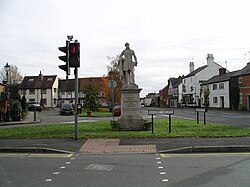Dunchurch
| Dunchurch | |
| Warwickshire | |
|---|---|
 Daventry Road and the Square viewed | |
| Location | |
| Grid reference: | SP485712 |
| Location: | 52°20’12"N, 1°17’23"W |
| Data | |
| Population: | 2,842 |
| Post town: | Rugby |
| Postcode: | CV23 |
| Dialling code: | 01788 |
| Local Government | |
| Council: | Rugby |
| Parliamentary constituency: |
Kenilworth and Southam |
Dunchurch is a village on the south-western outskirts of Rugby in Warwickshire. The 2001 recorded a population of 2,842 in the village.
History
The earliest historical reference to Dunchurch was in the Domesday Book in the 11th century which mentioned a settlement called Doncerce.
The core of the village has been declared a conservation area because it has many buildings of historical interest. Some of the buildings date from as far back as the 15th century are timber framed and still have traditional thatched roofs.
For centuries Dunchurch was an important staging post on two major coaching route; the road between London and Holyhead (now the A45 road, classified as B4429 through the village) and the road between Oxford and Leicester (now the A426). In its day, 40 stagecoaches plus the regular mail coach every day would stop at Dunchurch. Coaching inns developed in Dunchurch to accommodate these visitors (the "Dun Cow", the "Bell" and "the Star"). Other inns in Dunchurch were the "Mother Red Cap", "Crown" and "Red Lion". The "Bell" and "Red Lion" were destroyed by German high explosive bombs in November 1940. All other properties can still be seen today.

Many famous people throughout history stayed at Dunchurch. Most notably in 1605, the Gunpowder Plotters stayed at the Red Lion Inn (reputed to be the private residence now called 'Guy Fawkes House') in Dunchurch awaiting news of Guy Fawkes's attempt to blow up the Houses of Parliament. Had he been successful, the plotters planned to kidnap the King's daughter Elizabeth of Bohemia from nearby Coombe Abbey.
Other famous people having stayed in the village include Princess Victoria, later Queen, and the Duke of Wellington. Robert Stephenson stayed in Dunchurch whilst supervising the construction of the Kilsby Tunnel during the building of the London and Birmingham Railway.
Dunchurch is the birthplace of the 18th century hymnwriter William Tans'ur, and in more recent times of the athlete Katharine Merry. For many years it was the home of England cricketer Ian Bell.
The coming of the railways in the 1840s led to a dramatic decline in the coaching trade, and with the development of a major junction at nearby Rugby the importance of Dunchurch rapidly declined. From 1871 until 1964 the village was served by its own railway station on the Rugby to Leamington Spa line.
Churches
There are three churches in the village:
- Church of England: St Peter's
- Baptist
- Methodist
Big Society
The village has a sportsfield on Rugby Road donated to the village by Baron Waring in the 1920s. Currently Dunchurch & Bilton Cricket Club play in the summer months and Dunchurch Football Club play in the winter. Cricket has been played on the land since the 1800s. In 1999 Dunchurch Cricket Club merged with Bilton Cricket Club to form Dunchurch & Bilton Cricket Club.
Other groups in the village include: Dunchurch Silver Band, District of Dunchurch Brass, Dunchurch Festival Group, Guides, Dunchurch Health Walks, Scouts, Mothers' Union, Photographic Club, St. Peter's Bell Ringers, Dunchurch Twinning Association, Dunchurch and Thurlaston Women's Institute, Working Men's Club.
Statue

In the centre of Dunchurch is a statue of Lord John Douglas Montague Scott (1809–1860) a 19th-century landlord, Member of Parliament and younger brother of the 5th Duke of Buccleuch. The statue is by the Victorian sculptor Joseph Durham ARA.
At Christmas, it has been an annual tradition for a group of pranksters to secretly dress up the statue in the garb of a cartoon or TV character overnight. They have done this every Christmas for more than 30 years, More recently the statue was dressed up as an Olympian for the final leg of the Olympic torch relay sporting a headband and runners jersey.[1]
The statue was dressed up as Queen Elizabeth II during Her Majesty's Diamond Jubilee weekend celebrations.
Outside links
| ("Wikimedia Commons" has material about Dunchurch) |
- Lord of the Manor of Dunchurch
- Dunchurch Festival Group notices, etc.
- Dunchurch Parish Council
- Dunchurch Parish Council Papers
- Dunchurch Village Hall
- Churches:
- Music:
- Dunchurch and Bilton Cricket Club
- Dunchurch Photographic Society
- Dunchurch 1700-1950
- Schools:
- Pictures of Dunchurch and the area on Geograph.co.uk